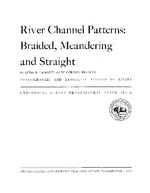River channel patterns: Braided, meandering, and straight
Links
- Document: Report (pdf)
- Related Works:
- Related Work Professional Paper 212-A: Ephemeral streams - Hydraulic factors and their relation to the drainage net
- Related Work Professional Paper 212-C: River flood plains: Some observations on their formation
- Related Work Professional Paper 212-D: Flow resistance in sinuous or irregular channels
- Download citation as: RIS | Dublin Core
Abstract
Channel pattern is used to describe the plan view of a reach of river as seen from an airplane, and includes meandering, braiding, or relatively straight channels.
Natural channels characteristically exhibit alternating pools or deep reaches and riffles or shallow reaches, regardless of the type of pattern. The length of the pool or distance between riffles in a straight channel equals the straight line distance between successive points of inflection in the wave pattern of a meandering river of the same width. The points of inflection are also shallow points and correspond to riffles in the straight channel. This distance, which is half the wavelength of the meander, varies approximately as a linear function of channel width. In the data we analysed the meander wavelength, or twice the distance between successive riffles, is from 7 to 12 times the channel width. It is concluded that the mechanics which may lead to meandering operate in straight channels.
River braiding is characterized by channel division around alluvial islands. The growth of an island begins as the deposition of a central bar which results from sorting and deposition of the coarser fractions of the load which locally cannot be transported. The bar grows downstream and in height by continued deposition on its surface, forcing the water into the flanking channels, which, to carry the flow, deepen and cut laterally into the original banks. Such deepening locally lowers the water surface and the central bar emerges as an island which becomes stabilized by vegetation. Braiding was observed in a small river in a laboratory. Measurements of the adjustments of velocity, depth, width, and slope associated with island development lead to the conclusion that braiding is one of the many patterns which can maintain quasi-equilibrium among discharge, load, and transporting ability. Braiding does not necessarily indicate an excess of total load.
Channel cross section and pattern are ultimately controlled by the discharge and load provided by the drainage basin. It is important, therefore, to develop a picture of how the several variables involved in channel shape interact to result in observed channel characteristics. Such a rationale is summarized as follows:
Channel width appears to be primarily a function of near-bankfull discharge, in conjunction with the inherent resistance of bed and bank to scour. Excessive width increases the shear on the bed at the expense of that on the bank and the reverse is true for very narrow widths. Because at high stages width adjustment can take place rapidly and with the evacuation or deposition of relatively small volumes of debris, achievement of a ,relatively stable width at high flow is a primary adjustment to which the further interadjustments between depth, velocity, slope, and roughness tend to accommodate.
Channel roughness, to the extent that it is determined by particle size, is an independent factor related to the drainage basin rather than to the channel. Roughness in streams carrying fine material, however, is also a function of the dunes or other characteristics of bed configuration. Where roughness is independently determined as well as discharge and load, these studies indicate that a particular slope is associated with the roughness. At the width determined by the discharge, velocity and depth must be adjusted to satisfy quasi-equilibrium in accord with the particular slope. But if roughness also is variable, depending on the transitory configuration of the bed, then a number of combinations of velocity, depth, and slope will satisfy equilibrium.
An increase in load at constant discharge, width, and caliber of load tends to be associated with an increasing slope if the roughness (dune or bed configuration) changes with the load. In the laboratory river an increase of load at constant discharge, width, and caliber resulted in progressive aggradation of long reaches of channel at constant slope.
The adjustments of several variables tending toward the establishment of quasi-equilibrium in river channels lead to the different channel patterns observed in nature. For example, the data indicate that at a given discharge, meanders occur at smaller values of slope than do’ braids. Further, at the same slope braided channels are associated with higher bankfull discharges than are meanders. An additional example is provided by the division of discharge around islands in braided rivers which produces numerous small channels. The changes in slope, roughness, and channel shape which accompany this division are in accord with quasi-equilibrium adjustments observed in the comparison of large and small rivers.
| Publication type | Report |
|---|---|
| Publication Subtype | USGS Numbered Series |
| Title | River channel patterns: Braided, meandering, and straight |
| Series title | Professional Paper |
| Series number | 282 |
| Chapter | B |
| DOI | 10.3133/pp282B |
| Year Published | 1957 |
| Language | English |
| Publisher | U.S. Government Printing Office |
| Publisher location | Washington, D.C. |
| Contributing office(s) | U.S. Geological Survey |
| Description | iv, p. 39-85 |
| Larger Work Type | Report |
| Larger Work Subtype | USGS Numbered Series |
| Larger Work Title | Physiographic and hydraulic studies of rivers (Professional Paper 282) |


